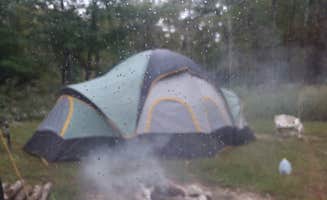Tent camping near Kaiser, Missouri centers on riverside conservation areas with primitive facilities. Most campsites feature natural surroundings along the Osage River watershed, approximately 15 miles from Lake of the Ozarks. Summer temperatures frequently exceed 90°F with high humidity, making spring and fall the preferred camping seasons. Sites typically remain open year-round but winter camping requires preparation for freezing temperatures.
What to do
Fishing opportunities: At Pikes Camp, campers find excellent river access for fishing. "Great little river access. Has a shaded grassy area for camping," notes one visitor who recommends being prepared for occasional nighttime visitors.
Water activities: The conservation areas provide multiple river entry points for kayaking and canoeing. Osage-Tavern Access offers water access with approximately 12-15 small sites with fire pits. "Right along the river so nice if your looking for water," explains a camper who visited after Labor Day.
Hiking trails: Several conservation areas feature walking paths through woodland habitat. The River Glade trailhead at Fiery Fork Conservation Area requires caution as one camper warns it "is overgrown and HIGH tick contact probability."
Wildlife viewing: Dawn and dusk hours provide optimal wildlife sighting opportunities. Conservation areas harbor deer, armadillos, and various bird species. Watch for ticks during warmer months, particularly when exploring tall grass areas or unmaintained trails.
What campers like
Natural surroundings: Fiery Fork Conservation Area receives praise for its natural setting. "Far from any city noise or roadway, there's two camp areas with many sites that are mowed/maintained with fire pits (and some concrete tables). Lots of beautiful hammock friendly trees," writes one visitor.
Affordability: Free camping makes these conservation areas attractive to budget-conscious travelers. One camper notes Fiery Fork is "A nice place if your on a budget and just need a get away."
Solitude: Many sites provide relative privacy outside peak seasons. "We were the only ones camping out which was nice," writes a visitor about their experience at Fiery Fork, mentioning that they found wildlife including armadillos, deer, and various bird species during their stay.
Camping areas: Sites often feature grassy surfaces with established fire rings. At Fiery Fork, a camper described, "The area was mowed, had a rock fire place, concrete picnic tables, a vault toilet, shade, grass for dogs to play frisbee, parking right beside your spot, trails, access to the river, good hammock trees, flat-level surface!"
What you should know
Access challenges: Many conservation areas require traveling on gravel roads. At Fiery Fork, "2 miles of gravel and high water areas you go through to get there" can present difficulties, especially for low-clearance vehicles. One visitor called the road "very sketchy for my 2008 Mazda 3."
No amenities: Scrivner Road Conservation Area and similar sites provide minimal facilities. "First come first serve basic camp area on the river. It has 1 fire ring in a gravel turnaround," explains a camper.
Cellular service: Expect limited or nonexistent connectivity at most locations. At Fiery Fork, a camper reported, "be prepared to have no cell signal...had to drive a couple of miles for a signal."
Trash management: No trash collection exists at most sites. A visitor to Fiery Fork advised bringing "extra trash bags" as "much of the area was covered in trash" and recommended preparing "to take your trash with you."
Water conditions: River access points may become inaccessible during high water. "If the waters too high, there's a bridge into the site that could be flooded so watch the weather," cautions one camper about Fiery Fork.
Tips for camping with families
Beach areas: Some river access points feature sandy areas suitable for children. A family camper at Fiery Fork noted it would be "a nice place to bring our kids since there is quite a bit of 'beach' at the river access for them to play and see nature."
Weekend planning: Arrive early on weekends to secure preferred sites. "Be prepared to have neighbors," warns a camper who stayed at Paydown Access, noting that while secluded during off-seasons, some locations see increased weekend traffic.
Safety considerations: Conservation areas typically lack emergency services. Prepare a first aid kit and know the nearest medical facilities, approximately 20-30 minutes away in most cases.
Activity supplies: Bring equipment for water and land recreation as no rental services exist nearby. Pack extra clothing for children as river play often results in wet garments.
Tips from RVers
Size limitations: Only smaller RVs can navigate the access roads to most conservation areas. For Fiery Fork, a camper recommends "smaller RVs due to the 2 miles of gravel and high water areas you go through to get there."
Limited hookups: No conservation areas offer electrical, water, or sewer connections. Self-contained units with adequate freshwater and waste capacity fare best at these primitive sites.
Ground conditions: Prepare for potentially soft ground during wet seasons. Some camping areas have turnarounds that can accommodate small trailers but may present challenges after rainfall.


